How Many Strings Does a Guitar Have?
On the Origins of Species
Peering back into the ancestors of the guitar means walking amongst the faces of our ancestors themselves. If you ask most people about when the first guitars were invented, as we know them today, they’ll point to Spanish luthiers (stringed-instrument makers) who evolved the modern guitar, as we know it between 1779 and 1850. However, the true origins of this species trace back far further.
Rewinding to Many Millenia Ago
The first traces of stringed instruments themselves tread back to the astonishing pre-historic times of 13,000 BC, with a steady evolution until medieval times. In fact, the legendary cave of the Trois-Frères in France, known for its invaluable cave painting reminders of our origins, depicts what many believe to be among the first indications of a stringed-instruments; a hunting bow, repurposed as a musical instrument appears to be depicted.
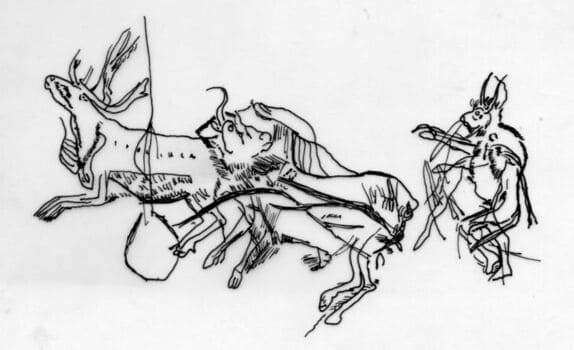
Remember too that this is amongst the earliest evidence of stringed-instruments, though they perhaps first appeared even long before 13,000 BC. It shows that humans, barbaric as we are, most likely saw value in the togetherness which shared rhythms and sounds offered.
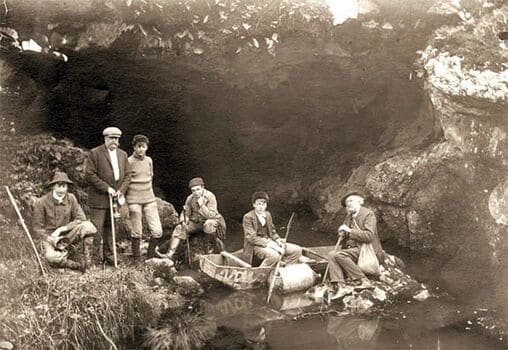
Marching forward from these nearly prehistoric times, that earliest example — a hunting bow as an ancestor of guitar and other stringed instruments — slowly morphed through time into new iterations; for example, more stringed were added, so that diads (two notes played simultaneously) and chords (three or more notes played simultaneously) were possible, bridges were added to lift the strings off the bows, and even tuning pegs were added to adjust the string pitch via varied tensions.
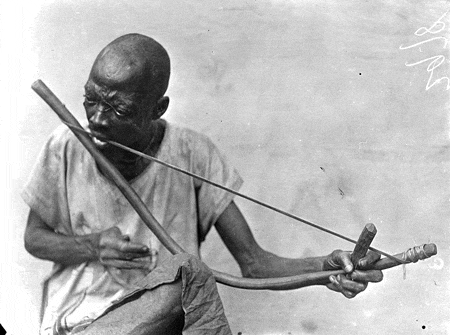
Much like watching a documentary on nature, where you can see how a bird evolved from a dinosaur, you can visually see how these “bow harps” evolved from hunting bows.
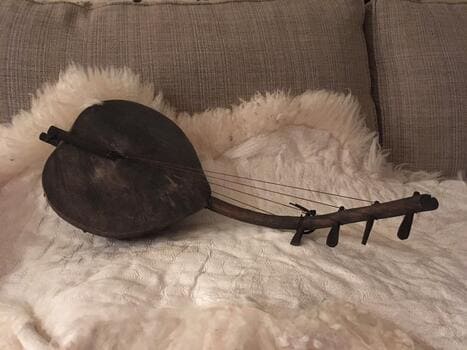
The Stringed Instruments of Early Civilizations
Eventually, early civilizations such as those in Mesopotamia, Babylon, and Greece amalgamated these modern ideas of bow harps with tuning pegs and bridges, creating lyres, lutes, and ouds.
Ouds

The origins of ouds are thought to go back as far as 3100 BC, mainly originating from ancient Mesopotamia. Built with a pear-like body shape, with a rounded back, flat top, and soundhole, the body contains a short, unfretted neck, with a severely angled headstock containing tuning pegs. Typically, the lutes of old had three strings, though the Islamic eras of ouds added a fourth string, then in the 700s a fifth string was added. String courses denote the groups of strings (much like a mandolin has four courses, with each course containing two strings), and ouds began with courses of single strings, though some ouds were later expanded to having courses of two strings like mandolins or 12-string guitars of today.
Lutes
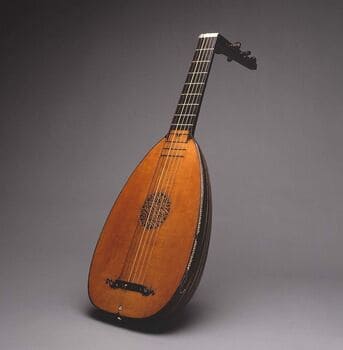
Tracing back to as far as 3100 BC like ouds, lutes look hinted remarkably at the advent of guitars much later on; defined as any plucked string instrument with a neck, fretted or unfretted, with a round and enclosed back, lutes also featured tuning pegs, soundholes, and bridges. Used extensively during Medieval and Renaissance times, the lute appears much like the Middle Eastern and North African oud, but is differentiated by potentially having a neck which was larger and fretted, while also being culturally used more in Europe. In fact, lute players are called lutenists/lutanists or lutists, and makers of lutes are called luthiers; today, any maker of stringed instruments is called a luthier.
Lyres
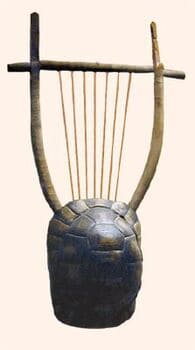
Dating back to 1400 BC, lyres had instrument bodies often made of tortoise shells, with two protruding arms, between which would lie anywhere from three to ten strings. Almost like a harp which fits onto one’s lap, the closest strings to the player would be thickest. The lyre’s tunings could range from chromatic (half-tone) differences in each string, all the way to intricate, enharmonic (quarter-tone) tunings. You’ll find that Romans called lyres citharas, and there are four distinct references made in the bible to these “kitharas”, which are translated to English as “harps”.
Over time, marked with these milestone innovations, variants of these designs sprung up throughout the early world. Indian instruments from 500 BC, for example, were discovered with anywhere from 7 to 21 strings, and much later on instruments like the guitarra latina and guitarra morisca became popular in medieval Europe, descending from those early lutes and ouds, which themselves descended from prehistoric bow harps; the term “guitarra” descends from the “cithara” or “kithara” names given to the lyre harps.

Creating the First “Guitars”
While the rest of Europe was entranced by the serenading sounds of lutes, Spain and Italy began work on their own variations. One such variation was the viheula, an instrument with 5 or 6 courses of 2 strings (so 10 to 12 strings in total), which featured a body, familiar to the guitars of today. Ouds and lutes, containing their pear-shaped, round-backed bodies feel like a far-cry from today’s hourglass-shaped guitars, though the vihuela was perhaps the first to feature this hourglass shape. Not only that, but it was also tuned, as many lutes were tuned, in 4ths, which is nearly the same tuning as today’s guitars.
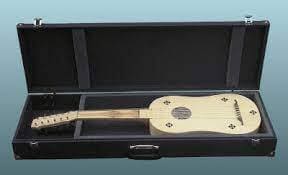
In 1779, a marked step was made towards the creation of the modern, 6-stringed guitar. Italian luthier, Gaetano Vinaccia, a member of a family of luthiers, created a variation of the vihuela with six strings, which began the quick track towards today’s guitars. Fast-forwarding just 70 years, around 1850, Spanish luthiers such as Antonio Torres Jurado expanded on these innovations, though altered the instruments’ proportions, creating a design with increased size, and the inner, fan-braced patterns.
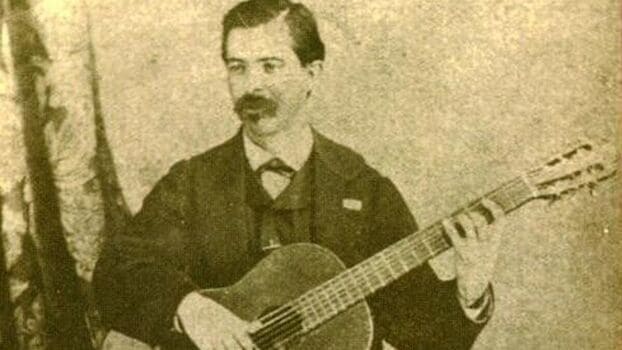
Torres’ design greatly improved volume, tone, and sound projection, which has practically remained unchanged ever since.
How Many Strings do Today’s Guitars Have?
Today, though you’ll find nearly all guitars with the same number of strings as Vinaccia’s 6-stringed innovation of 1779, there are many spawns of this with different numbers of strings, such that you may come upon 4 string tenor guitars, or 7 string guitars — all the way up to 20 string guitars. The practice of adding or subtracting strings has been common since the earliest bow harps, meant to extend or specialize the harmonic ranges of the instruments. Examples of those are touched upon below.
Also, it’s worth noting that, for stringed instruments with necks, such as guitars, the width of the neck varies to accommodate the number of strings, such that adding strings adds width to the instruments’ necks.
Four String Guitar
Known as tenor guitars, four string guitars were invented by Martin and Gibson in the early 1920s, containing a lute-like pear-shaped body, and a banjo neck. With 4 strings, the idea was that players of the 4-string tenor banjo could double on guitar. By the 1960s, makers such as Kay, Epiphone, Gretsch, and Guild had also released versions of 4-string tenor guitars. Normally tuned in fifths (C-G-D-A), similar to a tenor banjo, there are variations, such as Chicago Tuning (D-G-B-E, like the top 4 strings of a guitar). A great example of a tenor guitar player is Tiny Grimes, a legendary jazz musician who dazzled listeners with his superior melodic styles and haunting improvisations.
7 String Guitars
Perhaps surprisingly, 7 string guitars are not a recent invention. As early as the mid-1800s, composers such as Napoleon Coste wrote music, specifically for 7 string guitars. Also, legendary luthier Mario Maccaferri built 7 string guitars, perhaps partly since they were also quite popular in Russia, where they’re popular to this day. Typically, 7 string guitars add a low B to the guitar’s tuning, such that the tuning is B-E-A-D-G-B-E, with the extra bass string adding depth and harmonic options. However, the masterful Lenny Breau, who Chet Atkins regarded as one of the greatest players ever, added his 7th string as a treble string, with his tuning being, E-A-D-G-B-E-C, helping him play more intricate chord voicings.
8 String Guitars
Continuing onwards with 8 strings, the same desire for added harmonic options motivates the low B string and even lower F# string, extrapolating the pattern of the guitar’s bass-string tunings in 4ths, such that the tuning is F#-B-E-A-D-G-B-E. For examples of this, see players such as Charlie Hunter and Tosin Abasi.
9 String Guitars
As you can probably foresee the intervallic pattern by now, 9 string guitars add a lower B, lower F#, and even lower C#, so that guitar’s tuning is C#-F#-B-E-A-D-G-B-E. By this point, the guitar is often thought of as a hybrid bass & guitar. With the heavier, deeper sounds, these instruments are more popular among heavier genres, such as djent metal. Example players include Lucas Mann, Noyan, and Rob Scallon.
10 String, 18 String, and even 20 String Guitars
Continuing to add incredible amounts of bass strings to the “guitar”, these instruments continuously add lower bass strings in intervals of 4ths. As you would expect, physically the guitars require greater neck widths to accommodate the strings, which also necessitates a heavily-modified fretting hand technique, since any person’s hands can’t dream of wrapping around such necks. Also, the greatly augmented string tension of the guitars usually requires extra bracing within the necks (usually, metal “truss” rods, which combat any bowing due to excess string tensions). For an example of an 18 string guitar, see Youtuber Jared Dines, and for a 20 string guitar, see the player Stevie T for a glimpse.
12 String Guitars
The reason why 12 string guitars are outside of the 7 to 20 string guitars mentioned above is because what’s commonly known as 12 string guitars follow a wholly different pattern. Namely, rather than adding successive, separate bass strings in intervals of 4ths, 12 string guitars are, for all intents and purposes, simply 6 string guitars with double courses, similar to a mandolin. For example, the “6th string” (or better put, the “6th course”) actually is a double string, with the paired string tuned as an octave. Such is how the bass strings are tuned, in octaves, while the 3rd string is either tuned as an octave or in unison. Finally, the top two strings are tuned in unison. Sought after for their stronger sound projection, volume, and added harmonic texturing, perhaps the greatest 12 string guitarist ever was Lead Belly, who made innumerable contributions to popular music. Other great 12 string players include Blind Willie McTell and Leo Kottke.
Release Your Tension, You Now Know the Answers About Strings
Thus, you can see how the guitar arrived at its most common iteration of 6 strings over the vast expanses of time, venturing into nearly prehistoric times of the ancestral bow harps of early humans. Next, there have been many variations of guitars with added (or even subtracted) strings. All of this shows how instruments are not fixed in space and time, rather, they’re continuously evolving and changing as with everything else. Will “guitars” still most commonly have 6 strings in 100 years? It’s impossible to say for sure.